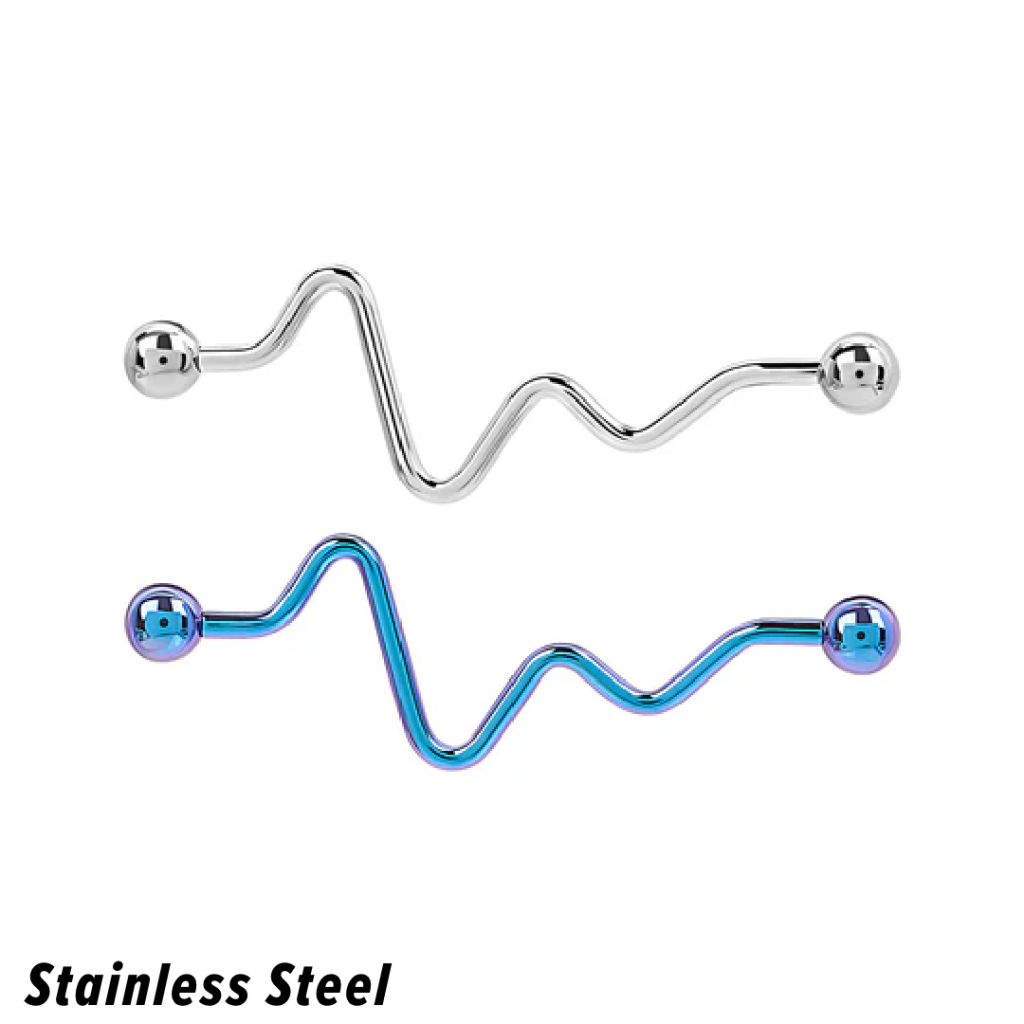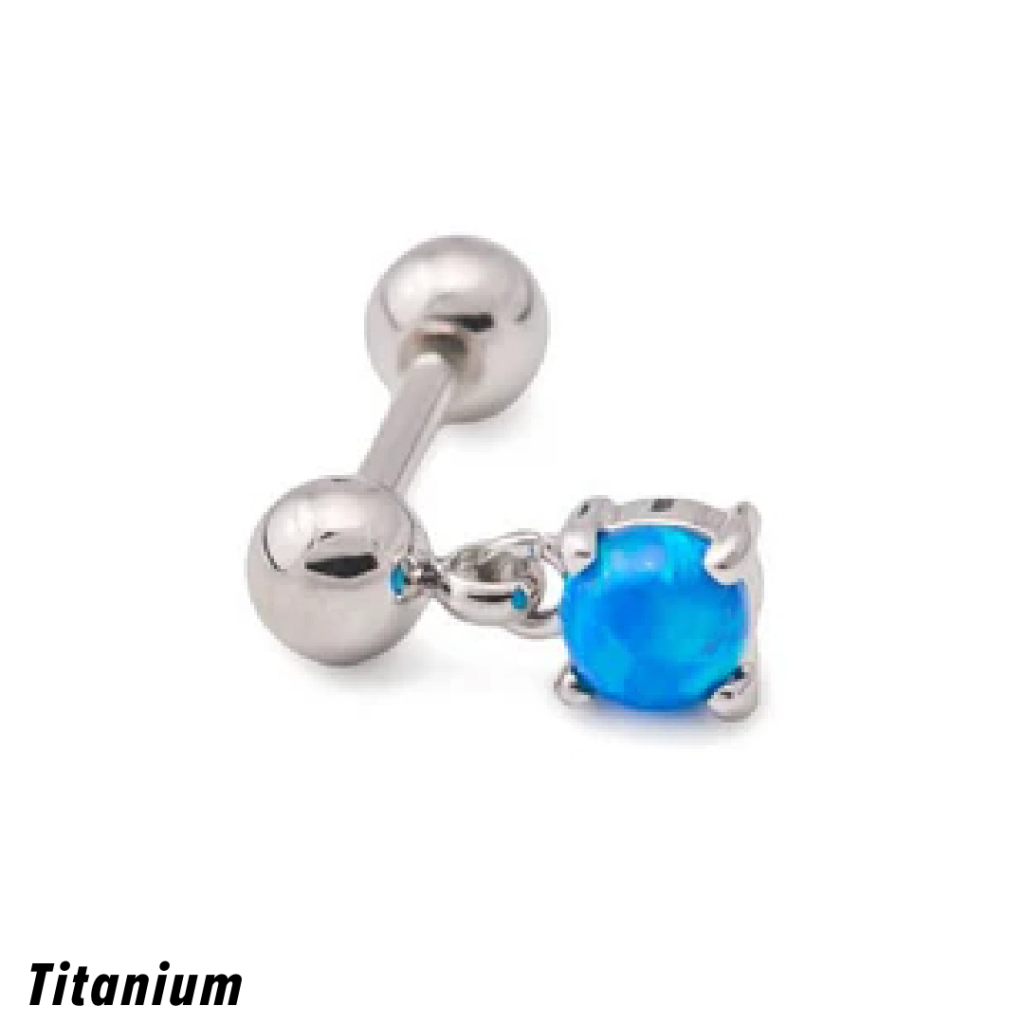If you’re new to piercings, words like hypoallergenic, inert, or corrosion-resistant might sound like a bunch of mumbo jumbo. Names like stainless steel, niobium, and titanium might even make your head spin, but don’t worry. Here’s the lowdown on the top three safest metals for body jewelry. based on longevity, strength, resistance to tarnish, and how easy they are to clean.
But first, let’s start with the basics: what makes these metals safer for healing and sensitive skin?
What are Hypoallergenic Jewely Metals?
For a metal to be premium for new piercings or sensitive skin, it needs to check a few important boxes:
- Hypoallergenic: It’s unlikely to trigger an allergic reaction.
- Inert: It’s chemically stable, meaning it won’t react with products, body fluids, or the environment.
- Corrosion-Resistant: Able to withstand exposure to moisture and air without rusting, tarnishing, or breaking down.
If a metal meets these standards, it’s considered safe for use in body jewelry.
The Big 3
When it comes to body jewelry piercing materials, three metals steal the scene: stainless steel, titanium, and niobium.
#3. Stainless Steel
Stainless steel is probably the most familiar metal on this list, and for good reason. It’s used everywhere, from medical tools to kitchenware. In the piercing world, surgical stainless steel stands out for its durability and corrosion resistance. That means it holds up well against body fluids and won’t break down easily.

To make the cut for body jewelry, stainless steel must meet ASTM F138 standards. The most common types used are 316L and 316LVM. These have low carbon content and, in the case of 316LVM, vacuum melted to remove impurities, making them safer and smoother for piercings.
Keeping Stainless Steel Piercings Clean
Thanks to its corrosion resistance, stainless steel jewelry is tough against tarnish. That said, it can still be prone to staining or discoloration over time. The good news? Cleaning it is simple. A quick wipe with white distilled vinegar, mild detergent, metal cleaner, or just soap and water will usually do the trick.
Protecting stainless steel is just as easy. Regularly cleaning your jewelry and applying a protective sealant can help guard it from body oils, dirt, and damage from everyday elements, keeping it looking fresh and lasting longer.
Why Stainless Steel Is a Good Hypoallergenic Jewelry Metal
Stainless steel body jewelry is a solid option for clients because it helps reduce the risk of infection during healing. It’s one of the hypoallergenic jewelry metals, making it a gentler choice for people with sensitive skin—both during healing and long after. Not to mention it’s the most affordable option of the three, which makes it great for first-time piercings or budget-conscious clients.

However, if you’re looking for something a little more premium, the next metal on this list might be more your style.
#2. Niobium
Niobium, also known as columbium in some places, is found mostly in Brazil. Prized for being soft, malleable, and super versatile, it’s also a great choice for piercers and sensitive skinned clients. Because of its flexibility, niobium can be shaped for all kinds of piercings—lips, nipples, navels, and more.
One of Niobium’s coolest features? It can be anodized to create a wide range of vibrant colors, making it perfect for clients who want to express themselves through their jewelry. Total win for anyone who wants something beyond the basics.

Keeping Niobium Piercings Clean
Niobium is naturally resistant to tarnish, so there’s no need for special cleaners or sealants. However, it can collect fingerprints and buildup from lotions, oils, or creams applied near the piercing.
Luckily, cleaning is simple. A gentle wash with mild soap and warm water will easily remove any residue. Since niobium doesn’t tarnish, there’s no need for harsh chemicals. In fact, strong cleaners can actually strip or damage the surface. Keep it simple, and your niobium jewelry will stay clean and vibrant.
Why Niobium is a Better Choice
Niobium is one the more corrosion-resistant, hypoallergenic jewelry metals, more so than stainless steel. That makes it an excellent upgrade for sensitive-skinned clients. And unlike plain silver-toned jewelry, niobium gives them the freedom to show off their personality with different colors and styles.
Another plus? Niobium is still affordable for you and your clients. So, ditch the boring, colorless metals and say hello to jewelry that’s colorful, customizable, and budget-friendly. That’s a win-win for your clients and your bottom line.

#1. Titanium
When it comes to piercing jewelry, titanium takes the crown. Titanium is as strong as stainless steel, even more corrosion-resistant than niobium, and incredibly reliable for long-term wear.
Titanium is the most hypoallergenic metal available, making it the top choice for sensitive skin and fresh piercings. It’s is even considered the only acceptable metal for body jewelry and medical implants in the United Kingdom. (In the U.S., either titanium or surgical stainless steel must be used, with rare exceptions made for people with extreme metal allergies). Plus, despite its strength, titanium is surprisingly lightweight, making it super comfortable, especially for healing piercings.
Titanium is also incredibly versatile. Whether you’re looking for a sleek straight barbell, a curved belly ring, or a tiny dermal anchor, titanium can handle it all with ease.

Keeping Titanium Jewelry Clean
Like niobium, titanium resists tarnish and discoloration, but it can still pick up dirt, oils, and residue that dulls its natural shine. When that happens, your jewelry can start to look a little lackluster.
Cleaning titanium is easy—a gentle wipe with mild soap and warm water is usually all it takes. For heavier buildup, an ammonia-free cleaner can help lift dirt without harming the metal. Just be sure to avoid harsh chemicals like bleach or chlorine, which can damage titanium over time.
Why Titanium is the Best Choice
Basically, for all the reasons mentioned above: strength, reliability, inertness, lightweight, versatility—the perks are endless. Plus, titanium isn’t just a strong and safe metal, it’s also used in medical implants, which tells you everything you need to know about how body-friendly it is.
Pro Tip: For hypoallergenic jewelry metals, look for ASTM F136 or F67 grade titanium; both are biocompatible and safe for long-term wear.
Like niobium, titanium can also be anodized to create a variety of fun colors, giving your clients plenty of room for self-expression without compromising on safety. So even your most sensitive-skinned clients can go bold, bright, or totally minimalist, whatever suits their style. You can even anodize titanium jewelry on site. Check out this quick video about the Painful Pleasures anodizing kit, here.

While titanium is the most premium choice of the three, it’s worth every penny. It combines strength, safety, comfort, and style all in one, making it the ultimate choice for professionals and piercing enthusiasts alike. When it comes to recommending jewelry to clients, titanium should be your top pick. Want to dive deeper into why it’s so great? Check out this guide: Top 5 Benefits of Titanium Body Jewelry.
Other Piercing Materials Worth Knowing
For those with extremely sensitive skin who may still react to metal jewelry, PTFE (also known as BioPlast or BioFlex) offers an excellent alternative. This flexible, hypoallergenic material is soft and metal-free—perfect for clients who need something even gentler.
Hypoallergenic Jewelry Metals That Won’t Let You—or Your Skin—Down
Stainless steel, niobium, or titanium are the go-to hypoallergenic jewelry metals for nearly every style of body jewelry—and for good reason. Barbells, captive bead rings, tongue rings, labret studs, dermal anchors, septum jewelry—you name it. Hypoallergenic metals help reduce skin irritation and support healthy healing. So, don’t hesitate to ask your piercer about hypoallergenic jewelry options. Especially when choosing body jewelry for your first piece.
No matter the material, size, or style, there’s a wide range of safe, skin-friendly options available to meet each client’s needs. Stocking a variety of hypoallergenic jewelry in your shop not only builds trust with clients, it’s also a smart move to help your business grow stronger and more sustainable over time.


Comments are closed here.